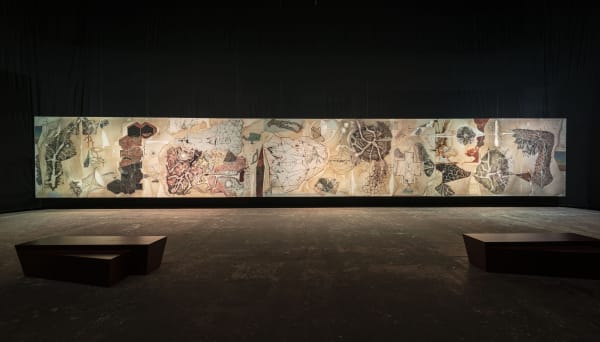Terranum Nuncius: Jitish Kallat
For ‘Covering Letter (Terranum Nuncius) [2019–20], Kallat draws from the two phonographic Golden Records that were hoisted onto the legendary Voyager 1 and 2 space probes launched by NASA in 1977. Currently located over 13 billion miles away from Planet Earth, the contents of this ‘time capsule’ were assembled for NASA by a committee chaired by Carl Sagan. It is expected to continue its cosmic journey well beyond the probable extinction of our species and our planet, carrying the barest traces to describe life on Earth and Human Civilization.
The gallery will be permeated with the sound of greetings to the universe in 55 languages. A large round table with over one hundred 3-D photographic transparencies placed on it occupies the space. To create them, Kallat has referenced the images decoded by Ron Barry, a US-based software engineer. Forty years after the images were first uploaded onto the Golden Record as sound files, Barry has converted the audio clips back to images as if they were accessed by an extra-terrestrial who would have to follow a similar procedure to view the images. These images range from scientific and cosmological diagrams, representations of our genetic make-up and anatomy, as well as other life forms, architecture etc., often annotated with measurements. This is an epic presentation of “our” world to an unknown other. At a time when we find ourselves in a deeply divided world, Kallat foregrounds these sounds and images for a collective meditation on ourselves as residents of a single planet, where the ‘other’ is an unknown ‘intergalactic alien’.
Also part of the installation is a bench that takes the shape of the hands of the Doomsday Clock. This symbolic clock, presented annually by the Bulletin of Atomic Scientists, represents a hypothetical human-made global catastrophe as "midnight,” and the proximity of the world to apocalypse as a number of "minutes" to midnight, ‘Ellipsis’ [2018–20] is Jitish Kallat’s largest painting to date, spanning approximately 60 feet (18 meters). Over the last two years, Kallat’s painterly practice has intersected more directly with his varying artistic inquiries and intellectual pursuits to produce a radical linguistic renewal. Taking the form of a deeply speculative and exploratory abstraction, indistinct impulses, private ruminations and discarded references are summoned and memorialized as pictorial assemblies. A meticulously hand-drawn graph underpins the entire painting. ‘Ellipsis’ is replete with signs and a web-work of free associations that challenge the viewer with a compelling tension, ambiguity and irresolution. Abstract gestures seem to crystallize, acquire perceptible form and resonate with meaning as if celestial orbits, geographical coordinate systems, botanical and topographical evocations begin to reveal the signatures of generative growth, evolution and entropy.
Born in 1974, Jitish Kallat has exhibited his work widely across the world in contexts such as galleries, museums and biennials. His oeuvre spans painting, photography, drawing, video and sculptural installations. In 2017, the National Gallery of Modern Art (New Delhi) presented a mid-career retrospective of his work titled ‘Here After Here’ [1992–2017] curated by Catherine David. Kallat has had solo exhibitions at museums such the Art Institute of Chicago, Philadelphia Museum of Art, Bhau Daji Lad Museum (Mumbai), the Ian Potter Museum of Art (Melbourne), CSMVS Museum (Mumbai), the San Jose Museum of Art and Art Gallery of New South Wales (Sydney), amongst other.
His work has been part of the Venice Biennale, Gwangju Biennale, Havana Biennale, Asia Pacific Triennale (Brisbane), Asian Art Triennale (Fukuoka), Curitiba Biennale (Brazil), and Kiev Biennale amongst others. His works are in the permanent collections of Centre Pompidou, Paris; the Art Institute of Chicago; M+ Hong Kong; the Brooklyn Museum; Victoria & Albert Museum, London; the Kiran Nadar Museum of Art, New Delhi; among many others. Kallat also served as the curator and Artistic Director of the second edition of Kochi-Muziris Biennale in 2014. Kallat lives and works in Mumbai, India.
-
 Jitish Kallat, Covering Letter (detail), 2020
Jitish Kallat, Covering Letter (detail), 2020 -

Jitish Kallat, COVERING LETTER (DETAIL) 2020
-
 Jitish Kallat, Covering letter (Terranum Nuncius), 2019
Jitish Kallat, Covering letter (Terranum Nuncius), 2019 -
 Jitish Kallat, Covering Letter, 2020
Jitish Kallat, Covering Letter, 2020 -
 Jitish Kallat, Ellipsis, 2018-20
Jitish Kallat, Ellipsis, 2018-20 -
 Jitish Kallat, ELLIPSIS, 2018-20
Jitish Kallat, ELLIPSIS, 2018-20 -
 Jitish Kallat, ELLIPSIS (detail), 2018-20
Jitish Kallat, ELLIPSIS (detail), 2018-20 -

Jitish Kallat, COVERING LETTER (DETAIL) 2020









